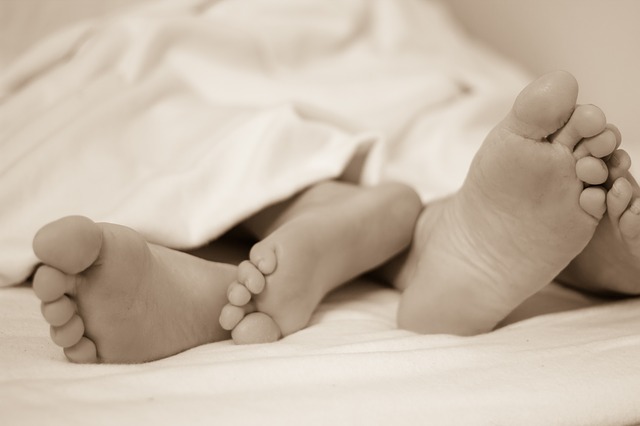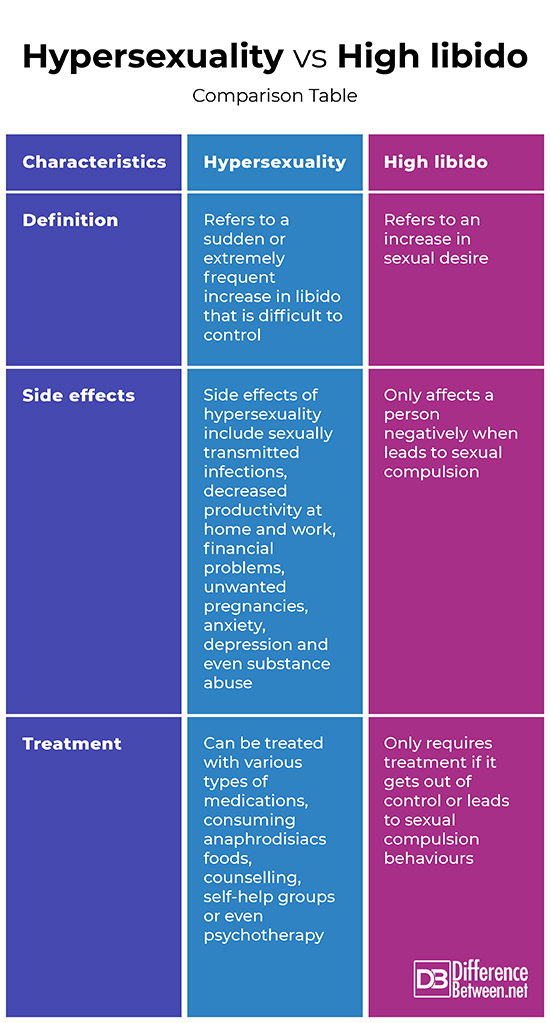Difference Between Hypersexuality and High Libido
Sex is an important part of all life. Not only is it enjoyable but also the source of life. However, everyone’s sex drive varies. It is a normal expectation for people to have a high sex drive. But when does normal become too much? You have probably heard cases of too high sex drive or have even experienced it yourself. Hypersexuality and high libido are some terms that are commonly used in reference to high sex drive. Let’s look at the differences between the two.
What is Hypersexuality?
Hypersexuality refers to a sudden or extremely frequent increase in libido that is difficult to control. Often, it can be a system of another disease or a primary medical condition. It can also be a side effect of some drugs such as those used to treat Parkinson’s disease. As per therapists and clinicians, hypersexuality is viewed as a type of obsessive-compulsive disorder. Some authors, however, assert that hypersexuality reflects a cultural dislike of sexual behaviour.
Symptoms of hypersexuality include:
- Intense and recurrent sexual urges, fantasies and behaviours that often consume lots of time and are beyond personal control
- Drive to perform sexual behaviours that lead to the release of tension and also lead to the feeling of remorse or guilt
- Inability to reduce the sexual behaviours or urges
- Problem establishing and maintaining stable and healthy relationships
- Engaging in sexual behaviours despite prior consequences such as financial strain and relationship problems
Hypersexuality is associated with problematic effects such as sexually transmitted infections, decreased productivity at home and work, financial problems, unwanted pregnancies, anxiety, depression and even substance abuse.
While the causes of compulsive sexual behaviours are yet to be established, some of the possible causes include:
- Medication- Some medications such as those used to treat Parkinson’s disease may lead to an unhealthy increase in sexual behaviour
- Health problems- If parts of the brain that affect sexual behaviours are damaged, you may experience compulsive sexual behaviour. Dementia and epilepsy are some of the known causes.
- Neurotransmitter imbalance- High levels of brain chemicals such as serotonin, dopamine and norepinephrine may cause compulsive sexual behaviour.
Hypersexuality can be treated with various types of medications, consuming anaphrodisiacs foods, counselling, self-help groups or even psychotherapy.

What is High Libido?
High libido refers to an increase in sexual desire. It is difficult to establish the baseline normal libido since it is different for everyone.
Causes of high libido
- Lower stress levels- Libido is likely to increase when experiencing low stress.
- Improved mental health- For most people, improved mental health increases libido. For instance, persons raised in a sexually repulsive religion or household may reconnect with their sexual urges and notice a high libido after working with therapists.
- Exercise and healthy eating- Healthy habits can lead to high libido via reduced stress, a boost in confidence and improved sleep.
- Stopping some medications- Some medications such as beta-blockers, birth control or antidepressants can cause low libido. If stopped, you may experience higher libido.
A high libido can occur when sexual activity feels out of control and may lead to sexual compulsion. This is a situation where a person loses control of their sexual behaviour, and in some instances, may necessitate medical help.
Signs of sexual compulsion include:
- Sexual behaviours negatively impact your life
- The inability to stop certain sexual behaviours
- Being secretive about sexual behaviour
- Being dependent on sexual behaviour
- Using sexual behaviours as an escape from issues such as stress, anger, anxiety and loneliness
- Difficulties in forming and maintaining healthy and stable relationships
Similarities between Hypersexuality and High libido
- Both can lead to sexual compulsion behaviours
- Both can have negative effects on a person’s life if problematic patterns are not treated
Differences between Hypersexuality and High libido
Definition
Hypersexuality refers to a sudden or extremely frequent increase in libido that is difficult to control. On the other hand, high libido refers to an increase in sexual desire.
Side effects
The side effects of hypersexuality include sexually transmitted infections, decreased productivity at home and work, financial problems, unwanted pregnancies, anxiety, depression and even substance abuse. On the other hand, high libido only affects a person negatively when leads to sexual compulsion.
Treatment
Hypersexuality can be treated with various types of medications, consuming anaphrodisiacs foods, counselling, self-help groups or even psychotherapy. On the other hand, high libido only requires treatment if it gets out of control or leads to sexual compulsion behaviours.
Hypersexuality vs. High libido: Comparison Table

Summary of Hypersexuality vs. High libido
Hypersexuality refers to a sudden or extremely frequent increase in libido that is difficult to control. It has various side effects and often requires treatment. On the other hand, high libido refers to an increase in sexual desire. There is no measure for high libido since it differs by individuals. While it is normal, it can lead to sexual compulsion behaviours, necessitating treatment.
FAQ: What triggers hypersexuality?
Hypersexuality can be triggered by distress, traumatic experiences, sexual abuse or mental illnesses such as bipolar disorder.
What causes high libido in females?
High libido in females is caused by a rise in estrogen levels during or before ovulation.
At what age does a woman’s libido peak?
While there is no age limit for a woman’s peak in sex drive, most experience a rise in libido at the ages of 18 and 24.
- Difference Between Profit Center and Investment Center - July 2, 2022
- Difference Between Anti-Trust and Anti-Competition - June 6, 2022
- Difference Between Stocktaking and Stock Control - June 6, 2022
Search DifferenceBetween.net :
3 Comments
Leave a Response
References :
[0]David J. Ley. The Myth of Sex Addiction. Rowman & Littlefield, 2014. https://books.google.co.ke/books?id=YlBQ8G56X7YC&printsec=frontcover&dq=Difference+between+hypersexuality+and+high+libido&hl=en&sa=X&redir_esc=y#v=onepage&q=Difference%20between%20hypersexuality%20and%20high%20libido&f=false
[1]Stein D & Hollander E. Clinical Manual of Impulse-Control Disorders. American Psychiatric Pub, 2007. https://books.google.co.ke/books?id=u2wVP8KJJtcC&printsec=frontcover&dq=Difference+between+hypersexuality+and+high+libido&hl=en&sa=X&ved=2ahUKEwiQiO-X0KjyAhVRJhoKHYtSAjAQ6AEwAnoECAoQAg#v=onepage&q=Difference%20between%20hypersexuality%20and%20high%20libido&f=false
[2]Martin C & Kinsey A. Sexual Behavior in the Human Male. Indiana University Press, 1998. https://books.google.co.ke/books?id=pfMKrY3VvigC&printsec=frontcover&dq=Difference+between+hypersexuality+and+high+libido&hl=en&sa=X&ved=2ahUKEwiQiO-X0KjyAhVRJhoKHYtSAjAQ6AEwBHoECAUQAg#v=onepage&q&f=false
[3]Image credit: https://pixabay.com/photos/maiden-portrait-hypersexuality-555650/
[4]Image credit: https://pixabay.com/photos/feet-bed-sleep-in-love-sex-224680/

So they’re the same thing?
No, they are not the same thing.
no they are not the same thing libido natural-my wf and created values we can live whether other’s aprove be sex-posititive and stop indentify youself as the illnes